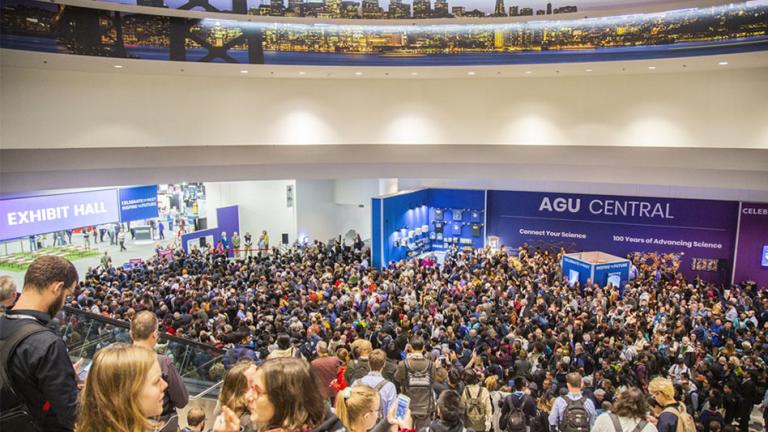
MIT Joint Program presentations highlight multiple sustainability challenges and solutions
By Mark Dwortzan | MIT Joint Program on the Science and Policy of Global Change
The preeminent conference for the advancement of Earth and space sciences, the AGU (American Geophysical Union) Fall Meeting draws more than 25,000 attendees from over 100 countries each year to share research findings and identify innovative solutions to complex problems. Organized around the theme “Wide. Open. Science.” and affirming “Open Science” values including scientific collaboration, transparency and accessibility, the 2023 AGU Fall Meeting will take place in San Francisco and online on December 11 - 15.
Among those researchers will be 12 co-authors of oral and poster presentations, and conveners of conference sessions, who are core members or faculty affiliates of the MIT Joint Program on the Science and Policy of Global Change. Listed below—links to each abstract, along with the names of Joint Program co-authors or conveners (in bold for lead authors or conveners)—their 22 presentations and sessions span multiple Joint Program research focus areas, including multi-sector dynamics, policy scenarios, infrastructure and investment, and Earth systems.
Categorized by primary research focus area, these linked presentations and sessions highlight recent findings by Joint Program researchers and their co-authors on several sustainability challenges and solutions.
Multi-Sector Dynamics
These presentations and sessions investigate potential scenarios, risks and transition states of interconnected Earth and human systems.
- Future Patterns of US Agricultural Land Use under Multiple Stressors (Angelo Gurgel, Xiang Gao, Jennifer Morris, C. Adam Schlosser, John Reilly, Sergey Paltsev)
- Disentangling the Changing Nature of Water Quality, Availability, and Equity in the United States (C. Adam Schlosser, Xiang Gao, Andrei Sokolov, Angelo Gurgel, Jennifer Morris)
- Multisector Dynamics: Science and Modeling for Societal Transformation I Oral (Jennifer Morris)
- Multisector Dynamics: Science and Modeling for Societal Transformation II Poster (Jennifer Morris)
- Advancing Complex Human-Earth Systems Science through Natural Language Processing, Graph Machine Learning, and Artificial Intelligence (Jennifer Morris)
Policy Scenarios
These presentations explore environmental and economic change under different climate, air pollution, and economic policies.
- Application of Scenario Discovery Techniques to Probabilistic Ensembles in Exploration of Energy Futures (Jennifer Morris)
- Emulating Spatial Patterns of Surface Temperature Responses to CO2 Emissions (Noelle Selin)
- Maximizing Air Quality Benefits of Organizational Climate Action: Evidence from Electricity Purchase and Personnel Business Travel (Sebastian Eastham, Noelle Selin)
Infrastructure and Investment
These presentations focus on adaptation and resilience to climate change and extreme events
- Urban Flood Modeling: The Influence of surface run-off modeling and Geospecificity in estimating Flood Extent and Propagation (Kenneth Strzepek)
- Incorporating Below Ground City Textures into Urban Flood Modeling for Enhanced Flood Prediction and Risk Assessment: A Case Study of the MIT CAMPUS (Kenneth Strzepek)
- Practical Steps for Achieving Equity in Water Resources System Planning: Lesotho Irrigation Investment under Climate Change (Kenneth Strzepek)
Earth Systems
These presentations explore changes and risks to the Earth’s interconnected land, ocean, atmosphere and biosphere systems.
Land and Ocean Systems
- Modeling Impacts of Wildfires on Soil Thermal and Hydrological and Carbon Dynamics in Northern High Latitudes (Ronald Prinn)
- Global-ocean carbon and biogeochemical response to input from rivers and coastal wetlands (Stephanie Dutkiewicz)
Advanced Global Atmospheric Gases Experiment (AGAGE)
- Long-term Comparison of NOAA and AGAGE Non-CO2 Trace Gas Observations at Common Sites (Ronald Prinn)
- On the Influence of Ocean Sinks and Hydroxyl Radical Changes on Estimated Lifetimes and Emissions of Halogenated Greenhouse Gases (Ronald Prinn)
- Anthropogenic emissions of chlorine-containing very short-lived halogenated substances in China (Ronald Prinn)
Environmental Impacts of Aviation
- Potential Impacts On Ozone And Climate From A Fleet Of Supersonic Aircraft Under Different Adoption Projections (Sebastian Eastham)
- Analyzing Zonal Asymmetry of Particle Transport in the Stratosphere: Is Injection Longitude Worth Considering for Stratospheric Aerosol Injection? (Sebastian Eastham)
- Assessing the Evolution of Contrail Impacts From 1980 to 2019 (Sebastian Eastham)
- Contrail Height Estimation Using Geostationary Satellite Imagery (Sebastian Eastham)
- Enabling Contrail Avoidance Through Robust Contrail Detections (Sebastian Eastham)
- Evaluation of the APCEMM intermediate-fidelity contrail model using LIDAR observations (Sebastian Eastham)






